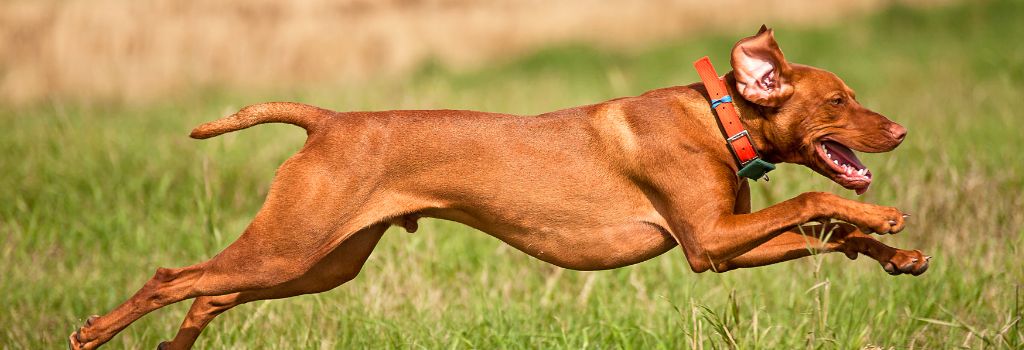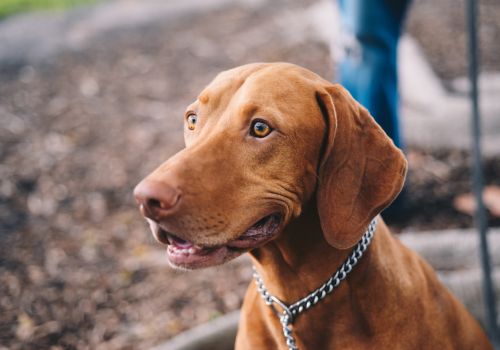The captivating world of the Vizslas, a breed that truly epitomizes loyalty, affection, and a love for all things active. Here's what you can expect from this fascinating and unique canine companion.
So Much to Love
- Vigilant Watchdogs: Vizslas are well-equipped with a robust bark that can alert you to anything amiss. Their vigilant nature makes them reliable watchdogs, keenly aware of their surroundings.
- The Energy Powerhouse: Athletic and full of life, Vizslas are an embodiment of vitality. If you have an active lifestyle, a Vizsla is your perfect match. Their boundless energy is infectious, and they thrive in families that can match their enthusiasm for physical activity.
- Family-Focused and Affectionate: Vizslas are known for their deep attachment to their human family. Their craving for human companionship goes beyond the norm—so much so that they're sometimes referred to as "Velcro dogs" for their tendency to stick close to their owners.
- A Breeze to Care For: With a short, low-maintenance coat, Vizslas make grooming a relatively hassle-free experience. This attribute is a significant plus for those who aren't looking for a high-maintenance grooming schedule.

Not Without Challenges
Despite their numerous positives, Vizslas come with their own set of challenges. They require a lot of physical activity and mental stimulation to stay happy. Without this, they can develop undesirable behaviors rooted in boredom or anxiety. They can also be overly protective of their family and territory if not properly socialized, and may exhibit signs of separation anxiety if left alone for extended periods.
Undeniably Worth It
Any challenges presented are easily outweighed by the immense joy and affection a Vizsla brings into your life. They are exceedingly trainable, thanks to their high intelligence and receptivity to positive reinforcement techniques.
A Rich History
Originating from Hungary—Vizsla means 'pointer' in Hungarian—this breed almost faced extinction in the early 1900s. Fortunately, a few were exported to North America in the 1950s, breathing new life into the breed. Historically, they are excellent hunting dogs specialized in bird and upland game retrieving. In contemporary times, they also excel in obedience and agility competitions.
Health and Lifespan
Vizslas are generally healthy dogs, with an average lifespan ranging from 12 to 14 years. Proper care, regular vet visits, and a balanced diet can ensure a long, happy life for your loyal companion.
To summarize, if you are in search of a dog who is as loyal as they are lively, as intelligent as they are interactive, the Vizsla could be your perfect pet. With their zest for life and devotion to their family, they're sure to provide years of love, joy, and spirited companionship.

Genetic Predispositions for Vizslas
Inherited Bleeding Disorders
You've probably fawned over your dog's sleek copper coat and boundless energy, but did you know Vizslas are prone to some unique health challenges? Yep, they can have inherited bleeding disorders that don't reveal themselves until there's a serious injury or surgery. So, don't be alarmed if you're asked to run some additional tests before Fido undergoes surgery. Better safe than sorry, right?
Hemolytic Anemia and Thrombocytopenia
It's like your Vizsla's immune system is throwing a little rebellion—against its own red blood cells or platelets. The result? Your pup could turn anemic, feel weak, and sport gums that look more like a snowfall than a rosy sunrise. Or, his blood might just not clot as it should, leaving him bruised and bleeding more than usual.Your doctor will do blood tests before any surgeries and likely prescribe steroids and other immune-suppressing drugs to calm the mutiny if needed. In extreme cases, a quick blood transfusion can be a game-changer.
Von Willebrand’s Disease
Another blood-clotting disorder that loves to hang out in Vizslas is Von Willebrand's Disease. Think of it as the guest no one invited but shows up anyway. Your veterinarian will run specific tests to make sure it's not crashing your dog's surgery party.
Epilepsy
Seizures in dogs can be super scary to witness, and Vizslas are more likely to experience them. These episodes can start as early as six months and may require lifelong medication. The key here is early detection and ongoing treatment. If a seizure happens, keep calm and make sure your fur-baby doesn't hurt himself. But hands off his mouth—trust us, you don’t want an accidental bite!
Eye Problems
Now, let's talk eyes. From cataracts to glaucoma, Vizslas can inherit a variety of eye conditions. Glaucoma especially is like the ninja of eye diseases—it's painful and fast-acting. If you notice any changes, don't wait; your dog's eyesight may depend on quick action.

Bone and Joint Problems
And let's not forget about their bones and joints. Dysplasia, especially in the hips and elbows, can make your Vizsla limp or struggle to rise from a sitting position. Keeping a watchful eye and catching the symptoms early can mean less pain and more playtime for your furry friend. And speaking of bones, ever notice your Vizsla hop a little while running? That could be patellar luxation, where the kneecap pops out of place but usually pops right back. While it might not need intense treatment, in severe cases, a surgical fix might be in the cards.
Arthritis in Older Vizslas
As your Vizsla ages, arthritis might rear its head. But don't let it slow down your senior pup! Early treatment and weight management can help them enjoy their golden years with less pain and more zest.
Skincare Woes in Vizslas: Watch Out for Sebaceous Adenitis!
Ever noticed your Vizsla's skin looking dry and patchy, especially along the top of his head, back of the neck, or back? Your pooch might be dealing with sebaceous adenitis, a skin condition they're particularly susceptible to. Generally noticeable between ages one to five, the earlier you get this checked, the better. Treatment usually involves a combo platter of fatty acid supplements and special shampoos to slough off dead skin and hair. So keep an eye out and consult your vet for the best treatment plan for your furry friend!
Mite-y Issues: The Deal with Mange
Good news: all dogs have Demodex mites living in their hair follicles. Bad news: Vizslas can sometimes have too much of a good thing, leading to mange. When these microscopic roommates overstay their welcome, you might see dry, hairless patches, often on the face or feet. While some dogs outgrow the issue, others need long-term care. The best defense is a quick trip to the vet to keep things from escalating.
Itchy and Scratchy: Allergies in Vizslas
Unlike humans who sneeze and get watery eyes from allergies, dogs' skin gets itchy. This is known as "atopy," and guess what? Vizslas often have it! The itchiest areas are usually the feet, belly, skin folds, and ears. Symptoms usually kick in between ages one and three and can worsen over time. From paw licking to face rubbing and frequent ear infections, it can be tough. The silver lining? There are lots of treatment options available to keep your Vizsla comfy.

The Big C: Cancer Concerns for Your Vizsla
Cancer is a reality for many dogs in their later years, and unfortunately, Vizslas are a bit more prone to certain types. Early detection is crucial. We recommend regular bloodwork and vigilant checks for lumps and bumps. Lymphoma is particularly more common in Vizslas but is also highly treatable with chemotherapy. Hemangiosarcoma is another type that Vizslas get more often. These bleeding tumors can be tricky because they don't show symptoms until they're quite large. So don't skip those senior wellness tests!
Watch That Bump! The Nasty Mast Cell Tumors
Vizslas are also at an elevated risk for mast cell tumors, a nasty skin cancer that needs early removal. These tumors can be deceptive as they resemble other skin issues. So if you spot a suspicious lump, get it checked out and possibly removed ASAP. The earlier you catch it, the better the outcomes are likely to be.
Home Alone: Dealing with Separation Anxiety
Some Vizslas just can't bear to be away from their human pals and can get anxious or bored when alone. To avoid this, make sure your Vizsla pup gets a good balance of alone time and playtime. A stable environment, a set routine, and plenty of mental stimulation and exercise can go a long way in preventing these common behavioral issues.
Don't have a vet in your area yet? We can help you find a local veterinarian.
If you have more questions, the GeniusVets Telehealth platform will give you unlimited access to text and/or video calls with board-certified veterinarians! To learn more click here.
